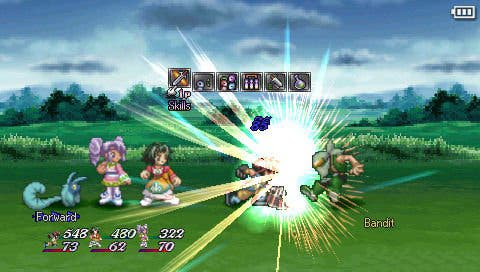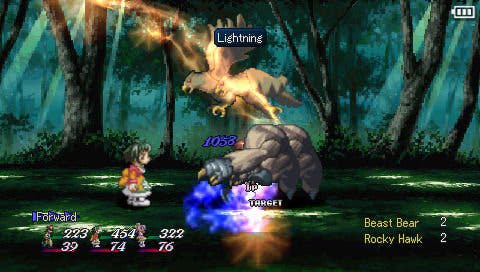Tales of Eternia
Eternal sunshine?
It says something that, immediately after its Japanese release, Tales of Eternia was hacked by fans, the original Japanese text extracted and replaced by an English translation before being sewn back together and promptly released onto the internet.
Quite what is says is dependent on your viewpoint. Maybe the game is so good that its accessibility to a western-tongued world was of such urgency to grassroots players that they'd risk life and litigation to make it available before a publisher could.
Perhaps it was just a group of showboating teen hackers getting drunk on the thrill of being gatekeepers to forbidden words and illicit understanding, possibly angling for a job in videogame localisation. Or maybe it was a statement from pro-globalisation kids fed up with getting games months and years after their Japanese pen friends - an inexcusable delay in the case of this PSOne port of Tales of Destiny 2, the translation for which was penned, punctuated, and polished a full six years ago.
Possibly it's just that some grubby little consumers want their games RIGHT NOW and FOR FREE else they'll cry and scream and hammer the floor with spoilt fists and hot, salty pirate tears.
But, most likely, it was just desperation: with so few decent RPGs available for a system that should be hemorrhaging them considering its hardware forefathers' abundance, Tales of Eternia represented an irresistible fruit. One that needed importing courier-fast just to satiate hungry RPG gamers twiddling emaciating thumbs next to a rapidly maturing but generically barren system.
Now the privilege of English-language play has been extended outside of the shady PSP underworld thanks to Ubisoft's decision to officially bringing the game out for Europe (before even America), allowing ethically robust gamers to skip and role-play guilt free though it's pixel perfect 2D primary coloured brilliance.

People play RPGs for two reasons: Firstly, the design: those stock gameplay mechanics that have been tweaked and streamlined with time's relentless tides. The typical Japanese developer picks each gameplay facet from a drop down list of options that have gone before and, by stringing them together, builds a distinct framework into which to squeeze their game.
This is the choice of battle mechanics, the way the levelling up system works, how play elements daisy chain together and what the world that frames the drama looks like. It's the choice of colour palette; the way this tree sways in the breeze under the patterns that smoke carves as it rises lazily from those chimneys; all the visual delights that urge you to push on to the next scene after the random battles hit tedium and traipsing across lonely fields becomes a forced march rather than a bracing scenic tour. What makes this good or bad is the implementation and a successfully balanced gameplay framework will shepherd a player through the game effortlessly and painlessly from start to finish.
The second reason players play is for the story: the onion layers of colour and character and drama piped into that framework. It's the developer's ability to craft loveable protagonists you secretly hate and detestable antagonists you secretly love; characters that urge you into caring enough to tirelessly reveal their statistical potential and transform wearisome number crunching into heart-felt genuine nurture.

It's the enjoyment of watching a beautiful or harrowing story uncurl, and in doing so being compelled to trace the lines that link the drama. It's the perfectly pitched narrative arc that prevents you from wishing that the demi-God currently threatening the world would just call Ragnarok and bring the whole sorry universe to stuttering crash already.
Tales of Eternia does the former brilliantly and the latter with mediocrity. As a result the reason why you like to play RPGs becomes a primary concern in determining whether you'll rate this game the runaway success everyone else says it is.
The framework is rock solid: delightful form and function built upon a fast paced battle mechanic which oozes arcade invention and accessible fun, all propped up by a well-constructed, coherent world. Battles follow the Tales series' trademark real time action dynamic. You take full control of just one character (selectable through the status menu) until the battle is complete, with the rest of your party members (up to four at once) being CPU controlled. The first few hours will see you blindly button bashing to trigger the super-deformed Street Fighter styled combat. Soon though, you'll start to settle into the more considered blocking, countering and combo attacks necessary to take down the increasingly demanding bosses. Enemies are encountered randomly but this maligned gameplay choice is far more palatable when their execution is so fast-paced and good.

Tales of Eternia's visuals are also exemplary, having been beautified even further in the shrink from 2000's CRT to 2006's LCD. The framerate in the 3D map is vastly improved over the PSOne original. Indeed, the game tightens up much of its older twin's scruffiness: almost all trace of loading times is eliminated and, in doing so, Namco vindicate the PSP and cast an iron challenge to lazier rival developers.
Sadly though, the story that fills the framework swings between light-hearted charm and dreary, clichéd banality. The central characters are brightly characterised but the story segments often feel rushed (notably the ending) and this key element of the game never quite settles. As a result, when, almost inevitably, the gameplay framework grows to be laborious, battles becoming too frequent and too inconsequential, there's little to push you to the finish line save the distance you've already come.
That said, this is by far and away the best RPG for the PSP currently on the market and, if you never make the denouement and staff roll, you'll likely have had enough fun climbing all over its most solid of frames that in the end, the Tales don't really matter that much after all.

